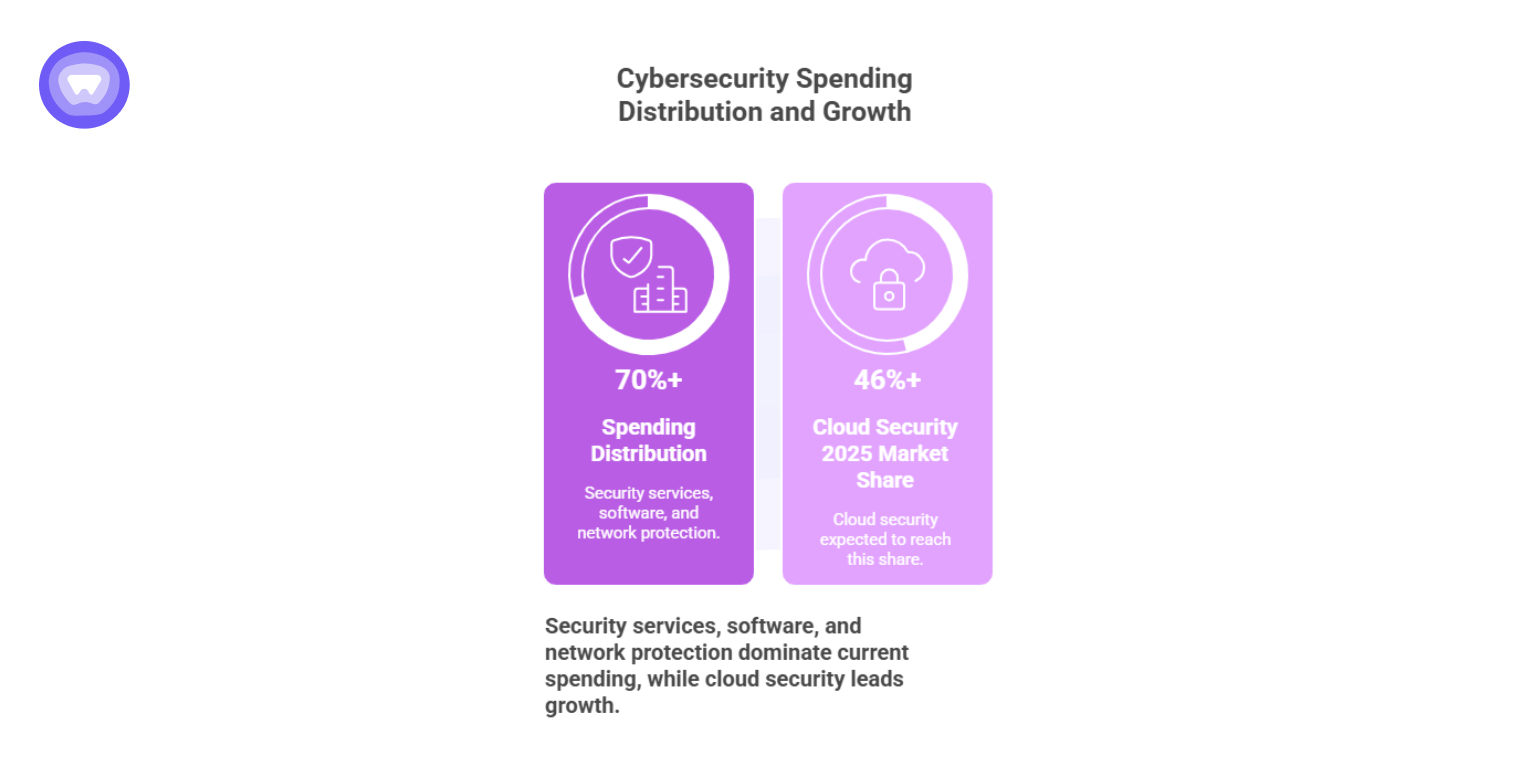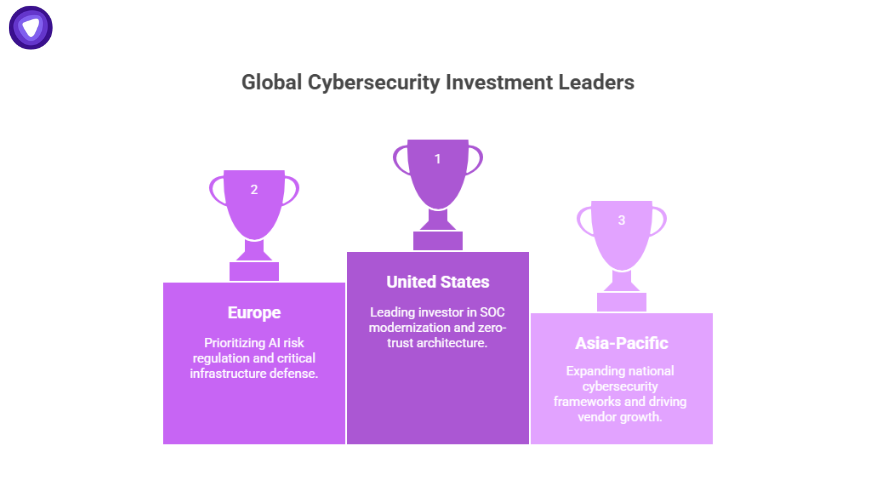Cybersecurity in 2025 is not about isolated tools. It’s about ecosystem resilience. Enterprises are no longer measuring protection in firewalls or endpoints but in mean time to detect, contain, and recover. Global spending continues to surge as ransomware, AI-driven attacks, and third-party vulnerabilities redefine enterprise priorities.
This report consolidates 2025’s most reliable cybersecurity spending statistics, strategic takeaways, and exclusive insights from PureVPN partners working across telecom, SaaS, and managed service environments.
Global Cybersecurity Spending Overview
Global Growth Trajectory
- Total global cybersecurity spending: projected at $212–213 billion in 2025, marking a 15% year-over-year increase from approximately $184 billion in 2024.
- Forecast period: both Gartner and IDC place compound growth between 12–15% annually, fueled by escalating data protection laws, remote access demands, and cloud migration.
- Distribution of spending: security services (managed detection, response, compliance), software (endpoint, SIEM, identity, and SASE), and network protection account for over 70% of total global spend.
Category-Level Breakdown
| Category | 2024 Spending (USD) | 2026 Projection (USD) | Average Annual Growth |
| Security Software | $95B | $121B | ~13% |
| Security Services | $77B | $93B | ~11% |
| Network Security | $40B | $48B | ~10% |
The largest shift in 2025 comes from traditional infrastructure controls toward service-based and hybrid protection, especially among organizations adopting multi-cloud or hybrid environments.
Cybersecurity Market Size and Growth Forecast
- 2025 market value: expected to reach $219 billion, maintaining steady CAGR growth above 14% through 2030.
- Long-term projection: market likely to exceed $560 billion by 2032, driven by increased regulatory enforcement and incident-driven investment cycles.
- Fastest-growing segments:
- Cloud security (~46% market share by 2025)
- Identity and access management (IAM)
- Data encryption and zero-trust architecture tools
- Managed Detection and Response (MDR) services
- Cloud security (~46% market share by 2025)

Regional Market Split
| Region | Share of Global Spend |
| North America (~43%) | Mature cloud adoption, compliance mandates (CISA, SEC) |
| Europe (~26%) | GDPR modernization, NIS2, AI governance frameworks |
| Asia-Pacific (~20%) | Rapid digital transformation, fintech growth, 5G rollouts |
| Rest of World (~11%) | Emerging markets, government digitization |
North America continues to dominate spending, but Asia-Pacific remains the fastest-growing region, expanding at over 16% annually due to aggressive cloud-first adoption and national cybersecurity programs.
The Cost and Scale of Cybercrime
Financial Impact
- Global cybercrime costs: projected to reach $10.5 trillion annually in 2025, up from $8.4 trillion in 2023.
- Average cost of a data breach: $4.44 million globally, with U.S. enterprises averaging $10.22 million per incident.
- Ransomware impact: average ransom demand now exceeds $2.3 million, often accompanied by multi-extortion tactics (data leaks + DDoS threats).
- Incident recovery: average recovery window extends 22–28 days, depending on business size and network complexity.
Strategic Implications
- Data exfiltration and identity compromise now account for over 70% of breach incidents.
- Cloud misconfigurations remain the #1 cause of data exposure.
Insurance premiums have climbed 35–40% since 2023, pushing companies toward proactive risk frameworks.
Investing in preventive infrastructure, such as encryption-at-rest, least-privilege access, and automated response, delivers higher ROI than post-breach recovery spend.
Emerging Technology and Spending Drivers
Artificial Intelligence and Automation
- Around 40% of new cybersecurity tools deployed in 2025 incorporate AI or machine learning.
- AI-assisted defense improves detection speed by nearly 40%, but also introduces new compliance and explainability challenges.
- Shadow AI—employee use of unapproved AI tools—features in roughly 20% of corporate breaches, increasing average breach cost by $670,000.
Workforce Gaps and Managed Security Demand
- The global cybersecurity workforce shortage exceeds 3.5 million roles, leading to heavier outsourcing toward MSSPs and SOC-as-a-Service vendors.
- CTOs are increasing automation budgets for Tier-1 and Tier-2 alert handling, saving ~25% on operational overhead.
Spending Priorities
| Rank | Spending Driver | Description |
| 1 | Cloud Security & SASE | Integration of identity, endpoint, and secure edge |
| 2 | Zero-Trust Architecture | Enforced through micro-segmentation and MFA |
| 3 | AI-Powered Threat Detection | Automated anomaly detection |
| 4 | Identity & Access Management | Role-based policy enforcement |
| 5 | Data Governance & Compliance | Privacy regulation alignment (GDPR, CCPA, APPI) |
2025 is the tipping point where AI and zero-trust converge into standard enterprise infrastructure, no longer optional pilot projects.
Sectoral and Regional Insights
Industry-Wise Spending Patterns
- Financial Services – Banking, payments, and insurance sectors allocate >18% of IT budgets to cybersecurity.
- Healthcare – Spending up 19% year-over-year, driven by ransomware resilience and electronic health record compliance.
- Manufacturing – OT (Operational Technology) protection investment rising due to connected device risks and industrial espionage.
- Government – National and municipal agencies face sustained ransomware threats; the U.S. federal budget for cybersecurity hits $13 billion in FY2025.
Regional Observations

- United States: Lead investor in SOC modernization and zero-trust architecture.
- Europe: Prioritizing AI risk regulation, critical infrastructure defense, and data residency compliance.
- Asia-Pacific: Governments in India, Japan, and Singapore expanding national cybersecurity frameworks, driving regional vendor growth.
Public and critical infrastructure sectors are now acting as spending anchors, setting the benchmark for private sector adoption cycles.
Budgeting and Organizational Trends
- 93% of organizations plan to increase security spending in 2025.
- Average allocation: 12–15% of total IT budgets directed toward cybersecurity initiatives.
- Zero-trust adoption: approximately 60% of enterprises are implementing or expanding frameworks.
- Supply chain attacks: have risen 742% since 2023, with more than half of incidents linked to third-party integrations.
- Board involvement: 70% of boards now include cybersecurity metrics in quarterly reports, shifting accountability from IT to governance.
Security budgets are no longer technical discussions—they are governance priorities tied to shareholder confidence and brand resilience.
Insights from PureVPN Partners
PureVPN’s enterprise and white-label partners operate across multiple verticals, including SaaS, ISP, and MSP environments. Their on-ground feedback reveals key operational trends in how cybersecurity spending translates into business outcomes.
Partner-Verified Insights
- Zero-Trust Acceleration: PureVPN partners observed that integrating VPN + Identity Access + Threat Protection reduces zero-trust rollout timelines by 30–40%.
- Procurement Velocity: Detailed audit documentation, SOC 2, ISO 27001, and no-logs statements, shortens vendor approval time by up to two weeks.
- Revenue Diversification: Bundling VPN with password managers or endpoint protection raises client retention by 18% on average.
- Incident Reduction: Partners report a 15–20% drop in first-line security support tickets after implementing managed VPN frameworks.
- Regulatory Readiness: Telco and ISP partners use PureVPN’s compliance stack to satisfy emerging data localization mandates in the EU and Asia.
As MSPs and SaaS providers evolve into security-first ecosystems, white-label cybersecurity services such as VPN and password management are emerging as the fastest and most profitable extensions to existing portfolios.
Recommendations for CTOs and Security Leaders
- Allocate at least 15% of IT budgets to cybersecurity, with priority toward detection, response, and zero-trust identity layers.
- Invest in cloud-native controls, on-prem defenses alone no longer suffice for distributed networks.
- Adopt continuous training to minimize internal threat vectors and social engineering risk.
- Integrate compliance monitoring early in system design rather than post-deployment audits.
- Benchmark against breach cost metrics instead of abstract ROI to justify future budget growth.
- Plan for regulatory divergence, prepare for varying privacy laws across the U.S., EU, and APAC jurisdictions.
- Outsource operational fatigue: Managed SOC, MDR, and secure VPN partnerships ensure 24/7 coverage without adding headcount pressure.
How PureVPN Supports Enterprise Cyber Defense?
PureVPN’s white-label program gives organizations an immediate path to embed enterprise-grade VPNs, password management, and threat detection inside their own products or internal IT stacks.
Core Advantages
- Custom branding: launch security offerings under your own label within weeks.
- End-to-end compliance: ISO-certified infrastructure and no-logs policy align with enterprise privacy frameworks.
- Multi-platform SDKs: integrate secure remote access into apps and networks seamlessly.
- Scalable pricing: usage-based billing optimized for MSPs, SaaS providers, and ISPs.
By combining network-level protection with identity-based access controls, PureVPN enables CTOs to extend zero-trust security beyond office boundaries, safeguarding distributed teams, partners, and clients.
Final Perspective
2025 marks a decisive year for cybersecurity spending. The global economy is transitioning from reactive security to measurable resilience.
The enterprises leading this shift share three common traits:
- Security budgets are aligned with business metrics.
- AI and automation are applied with governance, not hype.
- Partner ecosystems, such as PureVPN’s white-label solutions, are replacing isolated tools with integrated defense frameworks.
Security leaders who treat cybersecurity as a business enabler—not an expense—will be the ones shaping sustainable growth beyond 2025.
Sources
- PureVPN Internal Partner Analytics (Q1–Q3 2025): Aggregated data from the PureVPN White Label partner network.
- World Economic Forum — Global Cybersecurity Outlook 2025: https://reports.weforum.org/docs/WEF_Global_Cybersecurity_Outlook_2025.pdf
- Fortune Business Insights — Cyber Security Market, 2024–2032: https://www.fortunebusinessinsights.com/industry-reports/cyber-security-market-101165
- SANS Institute — ICS/OT Cybersecurity Budget, Spending, and Trends 2025: https://www.sans.org/white-papers/2025-ics-ot-cybersecurity-budget-spending-trends-challenges-future
- Statista — U.S. Government Cybersecurity Spending Estimates (2025): https://www.statista.com/statistics/675399/us-government-spending-cyber-security/
- Microminder Cyber Security — 2025 Statistics Report: https://www.micromindercs.com/news-announcement/cybersecurity-statistics
- Viking Cloud — 207 Cybersecurity Stats and Facts for 2025: https://www.vikingcloud.com/blog/cybersecurity-statistics
- Keepnet Labs & BlueFire RedTeam — Cybersecurity Statistics and Market Trend Insights: https://keepnetlabs.com/blog/cyber-security-statistics-and-trends
- Yahoo Finance — Daily Cyberattacks 2025: Key Statistics: https://finance.yahoo.com/news/daily-cyberattacks-2025-key-statistics-165800367.html
- Government of Canada (Cyber.gc.ca) — National Cyber Threat Assessment 2025–2026: https://www.cyber.gc.ca/en/guidance/national-cyber-threat-assessment-2025-2026


